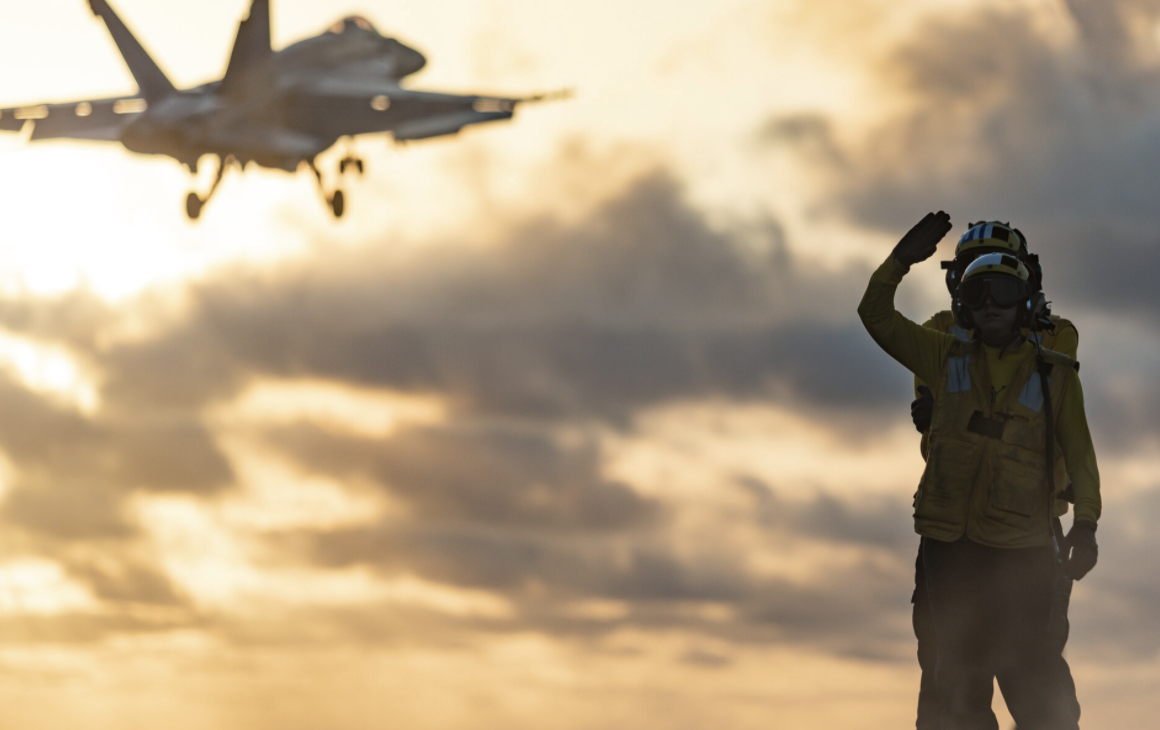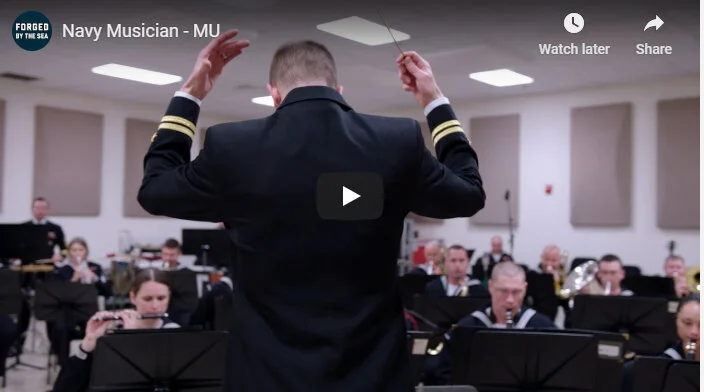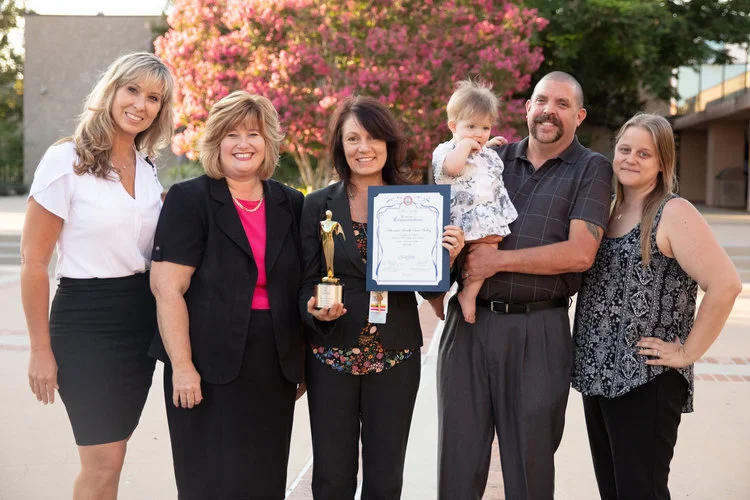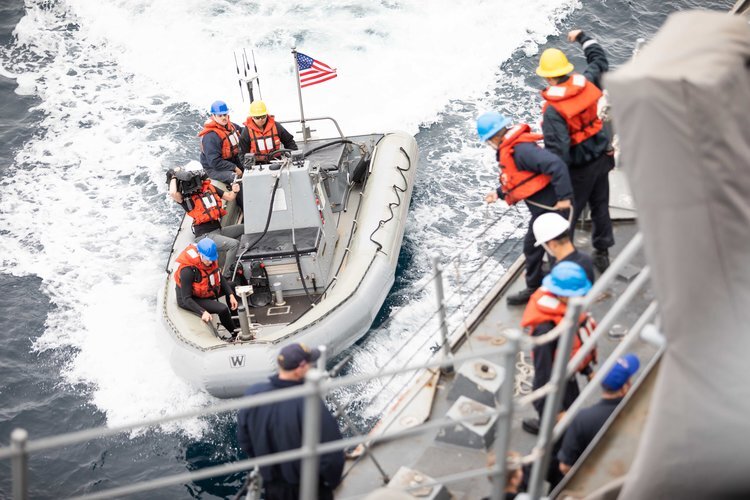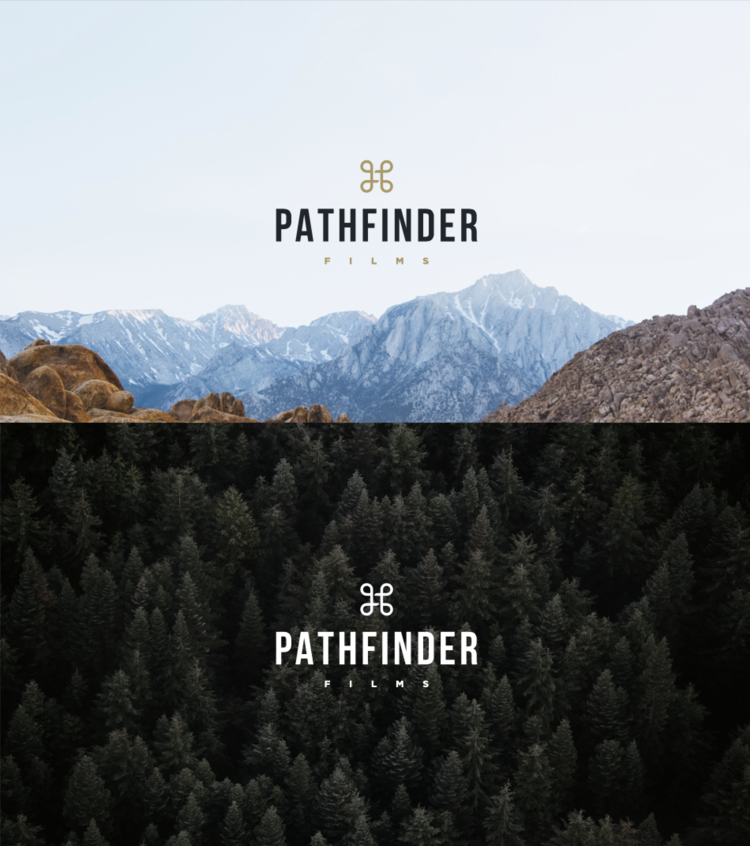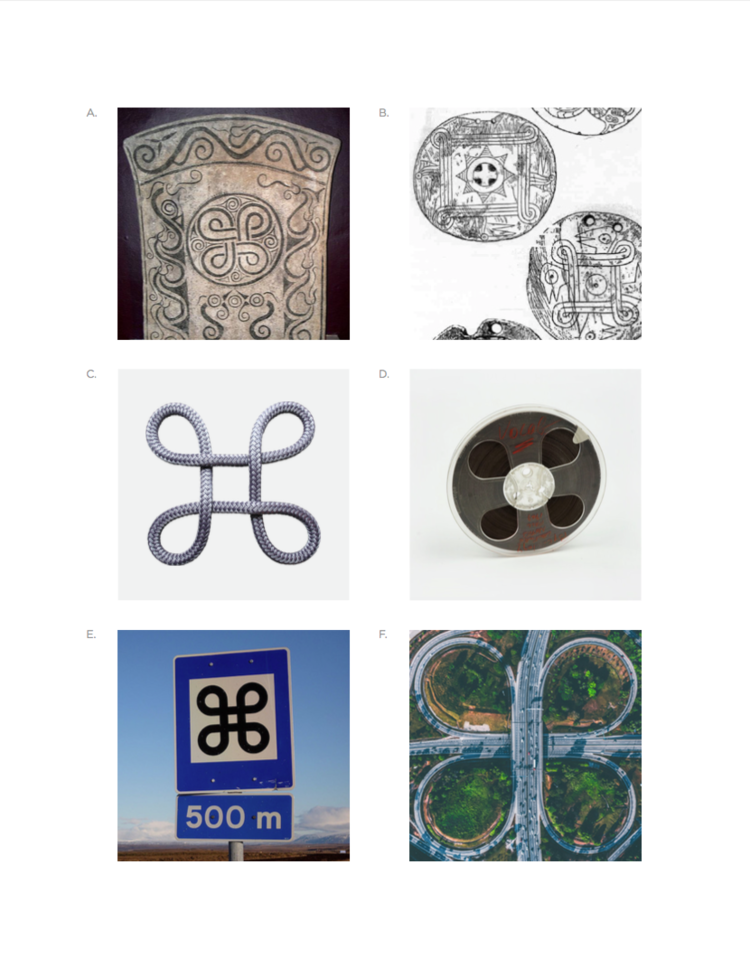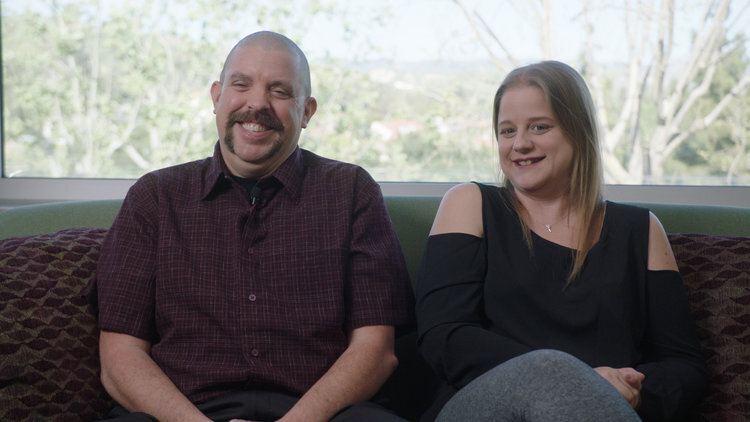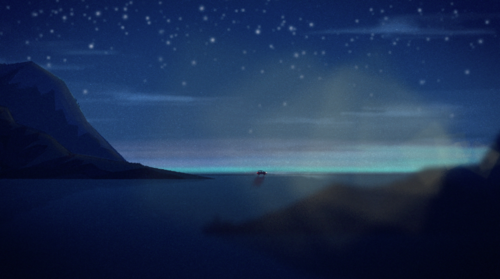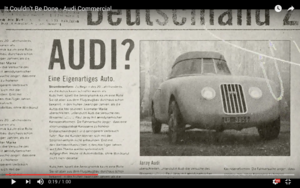U.S. Navy Branded Content: Aviation
One of the coolest production trips of our year was riding on board the U.S.S. Theodore Roosevelt (CVN-71) for a week. We walked on in San Diego and flew off in Alaska.
One of the coolest production trips of our year was riding on board the U.S.S. Theodore Roosevelt (CVN-71) for a week. We walked on in San Diego and flew off in Alaska.
The first half of the trip was focused on flight operations. Flight ops are loud, both on deck and throughout the ship. We found a quiet place in the ship’s museum to film interviews. Behind the subjects hung a flag that had hung in Teddy Roosevelt’s Oval Office, and the ship’s company is affectionately known as the “Rough Riders.”
On deck we discovered that allergies to JP5 jet exhaust are a real thing. But despite watery eyes, our crew got to do the foul-line dance between Cat 1 and Cat 2 during F-18 launches. That is probably one of the coolest experiences that a film crew can have.
Stand aside F-18s and warbirds, we’ve got a drone warming up on the deck!
Watch the Films
Director Leif Ramsey is featured on a podcast.
Picture's Up! was started by my friend David George. He's interviewed Sound Mixers, Camera Assistants, Composers, Animators, Gaffers, Actors. I've learned a lot about my own industry from his guests.
Listen to Picture's Up!
On the podcast our director Leif Ramsey talk to David George about recent production work for the U.S. Navy, including what it’s like to film on an aircraft carrier while underway.
Here’s one of the lessons that Leif has learned: Film is a collaborative medium. Find people that give you energy instead of take energy from you. If you can have a crew of people like that, you can go through a lot of adversity and still come out the other side liking each other and feeling good about what you did.
Listen to Leif’s episode on Picture’s Up!: https://player.fm/series/pictures-up-2475596/leif-ramsey-production-entrepreneur
Picture's Up! was started by our friend David George. He's interviewed Sound Mixers, Camera Assistants, Composers, Animators, Gaffers, Actors. We’ve learned a lot about our own industry from his guests.
Cantu Beauty Ads: Make Winter Summer Again
The production was for the global "My Curl. My Cantu." campaign, award-winning haircare for textured hair. Our scope included 57 video deliverables in three languages. Side-by-side with the video production, photographer Donald Page shot stills.
"Hey there. Can we build a garden in a studio?"
January kicked off with a bang. When everyone else was cozied up enjoying the warmth of the Christmas holidays we were gearing up for a production with Cantu Beauty and Sasha Group.
The project totaled 57 videos in three languages
The production was for the global "My Curl. My Cantu." campaign, award-winning haircare for textured hair. Our scope included 57 video deliverables in three languages. Side-by-side with the video production, photographer Donald Page shot stills.
Creative called for a color-pop studio environment for the instructional content, and a lush outdoor garden to film lifestyle sequences.
THE HITCH: It's the dead of winter in Atlanta. If you're looking for grey, rain, and wind-whipped brown twigs - we've got that in spades. Lush gardens? Not so much....
Enter Studio Midtown and Cinema Greens. We got two side-by-side studio spaces and built out a 24'x16' garden set complete with pergola and five different lighting looks.
Where did you guys find the garden?
Later that month in the edit suite: "Where did you guys find the garden?" Even our editor thought we had filmed outside.
Which proves that together we can: MAKE. WINTER. SUMMER. AGAIN!
The Teaser
The Making Of
"Life After" wins Gold & Judge's Choice at ADDY Awards
Animation Wins Gold Addy
The animated documentary “Life After” won a Gold & a Judge’s Choice Award at The Addys. Life After didn't start out as an animation. It was supposed to be an interview with b-roll documentary about a heart attack patient that survived after having CPR for 52 minutes.
We're super excited. Pathfinder's film Life After made for Adventist Health won regional awards in the American Advertising Federation’s District 7!
Awards
2019 Gold ADDY Award for Branded Content (District 7)
2019 Judge's Choice ADDY Award (District 7)
2018 Gold Telly Award
About the Film
Life After didn't start out as an animation. It was supposed to be an interview with b-roll documentary about a heart attack patient that survived after having CPR for 52 minutes.
When we interviewed the patient and his wife they were dynamic, playful, upbeat. They even laughed as they told the story.
Their experience deserved to be share in a way that was authentic to who they are. Out of that interview came an animated documentary.
The voices in the film are the voices of the patient and his wife.
Our Work is Live on the Navy's YouTube
Officer or Enlisted: This is your official invitation to rabbit-hole (not in the psychedelic experience way, but in the "get lost on the internet" way) on some of the coolest jobs in the Navy.
The first 18 videos from our production with the Navy are live on the Navy's YouTube.
This is your official invitation to rabbit-hole on some of the coolest jobs in the Navy.
Here are some of my favorite:
MU - Navy Musician
Navy Musicians are one of the main PR arms of the military, traveling around the world to represent the United States. And it felt like every person we talked to had at least a Master's degree. They were an amazingly warm and friendly community of musicians.
AO - Navy Aviation Ordnanceman
Probably the coolest interview location that I've ever been in. We were on the front of the flight deck on an aircraft carrier, wind whipping, ship underway at sea, and helos were snatching payloads of ordnance and ammo in the background. I could barely hear myself shouting the questions to the AO during the interview.
CS - Navy Culinary Specialist
Everybody has to eat, and these sailors do a great job of making food both tasty and look good. This is probably the most important job in the Navy for maintaining good morale among the sailors when they are at sea.
Again, here's the link to all 18 videos.
“Life After” Wins Gold Telly Award
We helped the hospital tell the patient's story in an unusual way: The voices of patient and his wife recounted the details of the event, while the scenes and experiences they described were brought to life with animation.
Seeing this photo was one of the most rewarding parts of my week. It's proof that telling stories that have an impact isn't limited to big brands or national TV.
In the photo is a heart attack survivor in his early 40s, with him are his wife, their youngest child, hospital leadership, and one of the nurses that cared for him.
The patient coded in the hallway outside of ER, and the hospital’s team did CPR for 52 minutes to keep him alive. Miraculously, he lived and had zero brain damage.
We helped the hospital tell the patient's story in an unusual way: The voices of patient and his wife recounted the details of the event, while the scenes and experiences they described were brought to life with animation.
At the national Telly Awards the film beat out submissions by massive brands like Google, Amazon, FoxSports, Harvard, PepsiCo and others — winning a Gold Telly.
How did a small-town hospital win a national advertising award?
The hospital led with their mission. They focused on the local, letting the people they served tell the story. And they took a risk on creative, embracing animation, an unusual approach for the video.
As the hospital’s community outreach leader said:
This award is a tribute to the story and the relationship of Shawn [the patient] and Angela [his wife]. With the film being seen and utilized by more people, the goal is to help others recognize early signs and seek help.
Watch the film and read an article that I wrote about the hospital’s approach. Their experience shows that even local brands and small-town hospitals can earn a national spotlight.
Watch "Life After"
Drone + Warship = Scary
We may have been the first ever (!?) to legally flying a drone around a US Navy ship while underway at sea. (Definitely to fly one as close as we did.)
Drones are cool. Flying a drone around a warship at sea is scary as what.
We may have been the first ever (!?) to legally flying a drone around a US Navy ship while underway at sea. (Definitely to fly one as close as we did.)
The ship has to turn off the spy radar, otherwise it could "fry the drone's electronics" and it would fall into the sea.
Drone's are programmed to fly from a fixed point on land.* If the controllers loose contact with the drone, and the ship is sailing forward at 16 knots, the drone thinks it's "home" is miles behind you, by default it will fly back to it's "home" point and splash down in the sea.
Landing on the deck of a ship is tricky. You've got wind, pitch, roll and it's moving at 16 knots.
We're flying a pro drone, if we lose it we kiss about $8k in gear goodbye. Also, we flew in sport mode which means top speeds of 65mph, (awesome for big moves) but flight times last roughly 20 minutes.
So get out your hanky and wipe the sweat off your forehead, because this is a high stress filming environment. :-)
*Attention drone nerds: There's a GPS transmitter that you can buy that makes your controller the "home" point. We didn't have one.
Away at Sea: Sixteen-Foot Waves. Man Overboard! Combat. Canons. Eye-Rattling F-18s.
Over the last 3 months we've done 30 days of production with the Navy. We've been capturing digital assets that show what sailors' jobs are like in each of the 140 different rates in the Navy. Our last embark was with the USS Momsen…
This is what 30 degrees of roll in 16-foot seas looks like from the pilot house of a missile destroyer.
Shortly after this picture was taken, the ship's XO commented on the sea state, "It'll be good for sleep tonight, but bad for doing anything else. We're running with the waves, and the ship makes a kinda snake-y motion. It rocks you right to sleep."
Over the last 3 months we've done 30 days of production with the Navy. We've been capturing digital assets that show what sailors' jobs are like in each of the 140 different rates in the Navy.
Our last embark was with the USS Momsen, a guided-missile destroyer. Normally, you hit rough seas off the coast of Oregon, but the seas had a mind of their own on this trip, and it was the coast of central California that gave us the roughest water.
Five minutes after calling "man overboard" they had rescued the dummy.
Boatswain's mates are the backbone of a Naval ship's operations. In the photo almost everyone you see, besides our camera op and the SARs swimmer, are Boatwain's mates.
While on board the USS Momsen we had the opportunity to film what's know as an "Oscar" drill. A dummy is sent off the side of the ship and the crew has 5 minutes to launch the rib, get a swimmer in the water and make the rescue.
To my surprise, there was no running. Everyone moved at a smooth, steady pace. After about 3 minutes, the rib wasn't in the water yet. I was sure that they were going to overshoot their target time, probably double it.
I was wrong. With 120 seconds remaining — the rib was launched, it zoomed out to Oscar the Dummy, and the SAR swimmer had made the rescue.
As the Navy SEALs say, "slow is smooth...smooth is fast."
Some sailors have never even seen the ocean before joining.
It's surprising how many sailors in the Navy come out of landlocked towns from the middle of America — like Witchita, Kansas and Sweetwater, Tennessee. Some have never even seen the ocean before joining.
Kaleb Brack is one of those guys from a landlocked town. He's a Damage Controlman (DC) on the USS Momsen that's from Kansas. As a DC his job is to fight fires and repair hull breaches. Basically, during the scariest times that you could ever have on a ship, fire and flooding, he's the guy that's trained to lead his shipmates in saving the ship.
He's not the only one, in the engine room we interviewed two Gas turbine system technician (GSM) females. They're responsible for maintaining the ships engines. One was from rural Mississippi where there was "nothing but cows." For her the hardest part of joining the Navy was passing swimming. Despite her fear, she overcame, and had nothing but positive things to say about life at sea serving in the Navy.
Combat: "Engineering is the muscle, combat is the brains of the ship."
That's what one Operations Specialist (OS) told me about her job.
We got the rare opportunity to film extensively in Combat on a guided-missile destroyer, the USS Momsen. In the photo is the commanding officer, CDR Elaine Brunelle, readying for a live fire exercise with the 5-inch deck gun.
Unlike what I pictured in my civilian brain, the captain is not in the pilot house standing at the wheel of the ship during a combat situation. She is levels below surrounded by screens with every type of data and specialists that are helping her evaluate each aspect of a rapidly evolving battlefield.
This was one of the coolest moments for me during our 30 days of production with the Navy. To give an idea for the uniqueness of the opportunity, the Gunner's Mates said that they only get to fire the 5-inch about once per quarter.
We learned later that the graveyard shift had spent 8 hours scrubbing the space so that classified information was protected from our cameras.
I'm super grateful for the previous shift's hard work and that the CO made it possible for us to film some of these rare moments.
Mommy works on a warship shooting big guns.
If you like things that go BOOM you'd like being a Gunner's Mate (GM) or Fire Controlman (FC) in the Navy.
In the photo a GM is cleaning up after a live fire exercise with a 50-caliber gun on board a missile destroyer. One of our film crew (red jacket) is asking questions.
I interviewed an FC that enlisted in the Navy when she was 30-years-old, shortly after having her third child. She joined because she wanted to provide for her family, and was not the only mother on board.
The parents I talked to said it wasn't easy, there are months at sea where they are only able to connect with their families through email.
It's a small consolation, but at least a GM or FC's child can say, "Mommy works on a warship shooting big guns."
GMs and FCs service and operate everything from the smallest weapons on board, 50-calibers, to the largest, the 5-inch canon and missile systems.
"You shake my bones and you rattle my brain. Your kind of love makes a man insane."
When an F-18 takes off and you're standing on the edge of the runway, the force from the engines actually makes your eyes rattle inside their sockets.
The temperature on the tarmac was 100+ at Lemoore Naval Air Station (where the photo was taken). It's one of the training grounds for the Navy's F-18 and F-35 pilots. For filming, we had driven out to an outlying runway to capture F-18s practicing touch-and-goes.
We were saturated in The Top Gun references. For example, "Iceman" was the actual call sign of the instructor in the shack by the runway grading the pilots on their landings (he says he gets a lot of flack for his call sign). And, while we were filming in the control tower, the production designers for Top Gun II showed up to take reference photos of the tower so they knew how to set dress the new feature.
This photo was shot on iPhone, so it's a pretty wide angle. I'd say we weren't more than 40 feet from the fighter's wheels as they hit the tarmac.
Filming for America's Navy
At every turn we soaked new experiences that made us proud to be American, proud to be filmmakers, and honored to work with the Navy. But nothing could beat getting to meet many of the dedicated sailors that serve our country each and every day.
The last three months of filming for America's Navy have been a wild ride. And for Pathfinder, the 4th of July marks the symbolic conclusion of production for #ForgedByTheSea.
During production, we went underway with two warships, an aircraft carrier in the Atlantic and a missile destroyer in the Pacific, and filmed at over a half dozen different bases.
Did you know that when a sailor goes on deployment with a ship that they could be at sea for up to 9 months, working 7 days a week? Or that America's 13 nuclear-powered carriers only have to refuel once every 25 years?
At every turn we soaked new experiences that made us proud to be American, proud to be filmmakers, and honored to work with the Navy.
But nothing could beat getting to meet many of the dedicated sailors that serve our country each and every day.
To celebrate the trip, we put together a photo blog from our first leg of production including filming aboard the aircraft carrier CVN 77 USS Bush in the Atlantic and on base in Norfolk, Virginia.
See the photo story: https://pathfinder.exposure.co/americas-navy-norfolk
PF's Video Clips on the Navy's Instagram
One of the first edits from over 26TB of footage that we've shot this spring. Enjoy!
Happy Memorial Day! This weekend we were super excited to see some of our work on the Navy's social media.
It's one of the first edits from over 26TB of footage that we've shot this spring. Enjoy!
https://www.instagram.com/p/BjNfMKlFyVS/?taken-by=americasnavy
Our 2018 Showreel
We're excited to share our 2018 reel with you. In the last year we made new friends, pioneered new genres, and won some awards.
We're excited to share our 2018 reel with you. In the last year we made new friends, pioneered new genres, and won some awards.
Includes: Clips from our first musical, "Cha Cha Land," a city branding campaign produced for the Chattanooga Chamber of Commerce. "Cha Cha Land" won Gold ADDY Awards both locally and regionally, and has now gone to nationals.
Award-winning work for Mueller Company that took us to 13 locations, 6 states, and 2 countries.
Scenes from our first animated documentary short, "Life After," produced for Adventist Health Simi Valley. It's the miraculous story of a 40-year-old heart attack survivor. The film won a Gold in the national Telly Awards for branded content.
[Since the writing of this post, "Life After" has won a Telly Award Gold for Branded Content: Fully Animated.]
Pathfinder’s New Visual Identity
We've made an update to our visual identity. The previous mark served us well for the first three years of Pathfinder Films, but we were due for a refined look that better embodied our way-finding spirit and the careful attention that we bring to our filmmaking.
Pathfinder's New Brand
We've made an update to our visual identity. The previous mark served us well for the first three years of Pathfinder Films, but we were due for a refined look that better embodied our way-finding spirit and the careful attention that we bring to our filmmaking.
We were pleased to partner with Counsel Creative for the branding, and will be working with them to update our website this summer.
Meaning Behind the Brand
The clover-like mark at the very core of this brand is rooted in historical relevance. The continuous creative validation helped us to revive an iconic legacy and fashion a new interpretation that stands ready for another test of time.
Reminiscent of the roadways that lead us to places unknown, this shape reminds us that the path for one isn't the path for all. Pathfinder Films helps clients identify the right path and find the story that matters most. The difference maker.
From heraldic charges that represented design, disciplines, ceremony and rank in 400 AD to pendants found in the lower Tennessee River as early as 1250 AD, this is a symbol of significance. In 1530 AD, this was known as a "true lover's knot". In more recent history, you'll see a similar shape on old film reels and in Nordic street signs marking places of interest.
“Life After” Animated Short Film
The video that shouldn’t have worked. A hospital in California came to us with a problem: They had a story that they were itching to tell about one of their patients, but they didn't know how to make it into a good video.
A hospital in California came to us with a problem: They had a story that they were itching to tell about one of their patients, but they didn't know how to make it into a good video.
Watch the Film: Life After
On paper it was a good story — a heart attack patient in their early 40s with a young wife, kids that almost lost Dad, heroics from the hospital’s medical team that kept him alive — but it’s a hard story to tell with video.
Imagine the Hollywood dramatization: Tense music, red ambulance lights flashing through windows of a suburban home. Dad is loaded on a gurney as his crying wife clings to his hand. His forlorn children are seen lined up on the curb through a receding ambulance window. At the hospital a handsome surgeon leads a well-trained medical team through action-movie-style shots to save the man’s life.
I knew the truth, "It’s melodrama. We’ve seen this story a thousand times."
I agreed to do a pre-interview with the patient and his wife, but my gut told me that this was going to be tough story to make into a good film.
To my surprise, their dynamic was playful and upbeat. They laughed, LAUGHED, as they told their story. Then they cried, only to lighten the mood and laugh again. These people were something special, and we had to find a way to tell their story with a different approach.
That pre-interview led us to the creative strategy for Life After.
Capturing the dynamic they had when the told the story together was critical. We scheduled 2-hour interview where we could film with both of them at the same time. It was less directed and more of a character piece — think StoryCorps, where the goal was to find out who they were as people.
Their story was laced with beautiful word-pictures like, “It felt like an elephant was sitting on my chest,” a visual that would have been impossible to recreate in a video.
From that moment forward, we didn’t record another second on camera. Instead, we recreated their experience with an animated documentary.
Animated documentaries are uncommon in the healthcare space. Maybe it’s because with animation it’s more difficult to maintain authenticity because you no longer see real people screen or the world they call home.
However, preserving the story’s authenticity was very important to the hospital’s creative team. So, the approach we took was using the real voices of the patient and his wife. Amazingly, none of their audio in the final edit was re-recorded or coached.
Being true to place was also important for the hospital. They’re based in a tight-knit community in Southern California that does not identify with the surrounding region of Los Angeles, Malibu, or Thousand Oaks. To maintain that connection to place we designed custom artwork that reflects the neighborhoods and landmarks that people from their town would recognize.
Why am I sharing all these behind-the-scenes details?
Because if you’re a healthcare marketer there’s good news! Your marketing doesn’t have to be overwrought, sterile, or corporate. It can be both authentic and fresh. However, getting there might mean leaving the safety and comfort of healthcare marketing’s “best practices.”
In my opinion, the creative team at the hospital, Adventist Health Simi Valley, deserves a big round of applause for their vision.
Here's to the people behind-the-scenes that made 2017 a great year.
Here's to the people behind-the-scenes that made 2017 a great year. When we started Pathfinder Films we decided that our company was a people company. Swanky gear is only a tool - if it helps helps our people succeed and makes our creative better, awesome.
When we started Pathfinder Films we decided that our company was a people company. Swanky gear is only a tool - if it helps helps our people succeed and makes our creative better, awesome. But gear isn’t and never will be the end-game. When we’ve had to make tough decisions about where to invest, we’ve chosen and will keep choosing people.
Here's to our clients and our friends. It's been an honor to collaborate with you.
"Hard decisions, easy life; easy decisions, hard life." — Jerzy Gregorek
*Thanks to Josh Ramsey for inspiring us with this quote.
Tips for Great On-Camera Interviews
I’ve spent hundreds of hours interviewing people, everyone from the CEO of Intel to a homeless man, and still I fell into the Memorization Trap…
I’ve spent hundreds of hours interviewing people, everyone from the CEO of Intel to a homeless man, and still I fell into the Memorization Trap.
Earlier this year I signed up for a conference in Chicago because the main speaker was someone who had a major impact on my career. Leading up to the event, the speaker offered limited access to one-on-one coaching. This was an amazing opportunity for a small business owner and all I had to do was apply with a 3-minute video.
Piece of cake! What could be easier than grabbing and iPhone and pitching to camera? You see I have some unique advantages:
I’m an expert at making great videos.
I’ve interviewed hundreds of people.
I’ve been interviewed on live TV.
I wrote out an outline, ran it by my team at Pathfinder to make sure the approach was good, and PRESTO! I’m ready to record.
That’s when things took a wrong turn…the iPhone started rolling and my mind went blank. I looked at my notes, then back to the iPhone, then back to my notes. A voice in my head said, “This is not going to end well...”
I started speaking, but it was like I was in a wind tunnel -- I couldn’t hear myself. I’d get 70% of the way through a thought and forget the next word: “What’s the word? What’s the word?? It’s the word we use to describe how we get clients….” Nothing. I took a sheepish look back to my notes, “Oh yeah, referrals. The word is referrals.” UHHHHGGG!
Cut. Start over.
I was stuck in the Memorization Trap, trying repeat exactly what I wrote. On the next take I made it all the way to, “clients”... and my mind went blank again.
Cut. Start over.
After 60 minutes I still didn’t have anything usable, let alone good. My ears were pulsing in time with my heartbeat, my throat was tense and I’m angry with myself.
Why did it feel like such a big deal? Why couldn’t I MAKE MYSELF do better? I’m just a guy sitting in his own office. I had all the time in the world to get it right.
Let’s take a look at how the Memorization Trap might happen to you.
You know you’re going to be on camera and that there’s stakes. You want to look good and sound smart, so you write out your thoughts. You review your notes by focusing on keywords and phrases. Then when it’s time to deliver on camera your mind goes blank. After the first mistake you feel even more nervous. It feeds on itself until you’re left feeling ill, angry, and embarrassed.
Often you’ll find that the Memorization Trap catches people at the worst time: A high-pressure environment with tens of thousands of dollars on the line. The classic example is when your organization has hired a camera crew for a day to interview your co-workers, or the CEO, or when you're trying to document a customer’s experience on camera.
With the clock ticking people in the room will try to help out: They’ll tell the interviewee, “Relax. No stress. You’ll get it.” The person will nod, laugh nervously and try again, only to stammer to a stop even sooner. Feeling like they let the whole room down, the interviewee berates herself for the failure. “Stupid. Dumb. What’s wrong with me? Just get it right.”
Someone will then try and help by offering a line, “Why don’t you say it like this…” For the first 5 seconds the interviewee does beautifully, all of the sudden just as you think she’s about say it just right, the two ways of phrasing the thought collide mid-sentence, and the words come out in a jumble -- like a slam poet reciting a terrible haiku.
You want to help but somehow can’t, and the interviewee feels defeated. They think, “I’m terrible on camera.” Or, “I’ll never do that again.”
I’ve seen this type of experience haunt capable and well-spoken people for years.
The good news is there’s a simple mindset you can adopt to help even the most nervous person overcome the Memorization Trap and do well on camera. It doesn’t require media training, an executive coach, or a psychologist to reconstruct their psyche!
How to get amazing on-camera interviews from almost anyone
There’s a couple of basics before you start filming:
Plan on editing. Don’t expect yourself or your subject to deliver a 5-minute speech word-perfect.
Have subjects look at the interviewer not the camera. Most people aren’t comfortable having conversations with inanimate objects.
Now that the easy stuff is taken care of, it’s time to help people shine.
1) Focus on conversation flow, not specific words and phrases.
People read nonverbal cues before registering what the person is saying. If my voice cracks while I’m talking about our value proposition, the first thing the viewer thinks is: “This guy is nervous. Why is he nervous? Is he credible? Does he know what he’s talking about?”
The best way to get a great result from someone without media training is to help them have a good conversation. The more comfortable you can get them, the smoother the conversation flows and the more confident they become.
2) “Coach” with good questions.
Have an interviewer coach them through the conversation while they are on camera. (This can be a professional or someone on your team.) Warning! Coaching is not feeding them lines. A good coach is someone who can get them into a flow by asking questions. It’s okay if they miss something. Keep a mental checklist and circle back around to it later by asking again in a different way.
Note: Avoid the scenario of supervisors interviewing subordinates. The power dynamic is too transparent and the interviewee will come off as defensive.
3) The Warmup: Start simple. Build to complex.
The easiest way to get someone into a good flow is to start simple. Don’t start by asking about the most important thing. Begin with what they had for breakfast, ask them about their drive to work or what they’re going to do with kids that evening. Then piggyback on their answers -- tell them about a similar experience that you’ve had or share what your day has been like.
We don’t expect opera singers to jump on stage and sing a song from Figaro without a careful warm up for their vocal cords, so why do we expect that an untrained person will be able to jump right into a smooth delivery on camera?
Tip: A good warm up can often do more than the “perfect” question at helping an interviewee succeed.
Interviews are a performance
Even though we don’t think about it this way, interviews are a performance. The next time you watch a great interview, pay attention. You’ll probably find that the confidence and flow of the delivery far outweighs perfect sentence construction or how many keywords they use.
A video with great interviews (and it’s funny)
A video with great interviews (and it’s funny) When your creative feels a little flat what can you do to fix it? Case-in-point: Interviews are something that I’ve thought about a lot because it’s a skill I rely on.
When your creative feels a little flat what can you do to fix it?
Case-in-point: Interviews are something that I’ve thought about a lot because it’s a skill I rely on. I’ve had to interview everyone from a homeless man to the CEO of Intel. Interviews are used for brand stories, in testimonials, and yes, in documentaries.
Despite their versatility, 99% of creatives start to die inside when they hear the word “interview.” It’s easy to think about interviews like the cardboard of storytelling — you need it to ship the package, but boy is it dull.
How do you take something as common as cardboard and make it feel fresh?
Enter Little Tickets. With this video JetBlue’s creative team took the concept of the interview and made it special again.
I know what you’re thinking: Round of applause for JetBlue, they spent a fortune and made a great ad. Okay, okay. So you’re not JetBlue. And maybe you don’t have a bucket of money to build a Lemony Snicket storefront on the streets of New York (although, that is super cute).
You don’t need to be at that level to take a worn out creative format and made it great. Let’s nerd out a little:
Lesson #1: Do the Opposite
The creative brief for Little Tickets could have been, “interviewing prospective customers about airline travel experiences.” That sounds pretty dull. I’m imagining a series of adults talking in annoyed tones about uncomfortable seats and overpriced bottled water.
JetBlue made interviews fresh by doing the opposite of what you would expect:
Instead of adults, JetBlue interviewed children.
Instead of deciding for them, they treated the children as the decision makers.
Instead of kids getting a gift, the kids got to give a gift to their parents.
They were so thorough at doing the opposite, that they even built a whole tiny world as the interview setting for the video.
Lesson #2: Plan a Surprise
Little Tickets also leveraged off of a planned surprise. At the end of each interview the children were given the actual trip that they had dreamed about. It was a surprise ending for both the viewer and the children, and the twist kept the interaction fresh for everyone.
Lesson #3: Lead, Then Follow
The interviewer used a subtle skill that elevated Little Tickets from amusing to heartwarming. Can you guess what it is?
He listened. A good conversation starts with empathy and a genuine desire to understand what the other person is saying. The honest answers the children gave could never have been scripted.
Hive-five to Little Tickets for reinventing the interview!
Tagged: little tickets, interviews, creative
0 Likes
This Video Made Engineers Teary-Eyed
Great videos are hard work. As you'd expect in East Tennessee after a summer rain shower, steam rolled off the asphalt. The humidity was 100% and I'd sweated through my short-sleeved shirt.
Great videos are hard work.
As you'd expect in East Tennessee after a summer rain shower, steam rolled off the asphalt. The humidity was 100% and I'd sweated through my short-sleeved shirt.
Greg, the company's president, had arrived from the airport 20 minutes before. He was dressed in slacks and a blazer, and the location for filming was a 10-minute walk through a non-air-conditioned manufacturing plant.
It was lunch time, stomachs were growling, and we were trying to find a spot out of forklift traffic with a nice background and tolerable noise to film Greg's line. He whipped off his blazer, wiped his forehead and said, "Okay, let me see if I can get it right this time."
All that for one shot in a video that we filmed across 13 locations, 6 states, and 2 countries. Let me underline it: Great videos are hard work.
So why did Mueller Company believe that an internal marketing video for employees was a good investment?
They knew that inspiration is exponential.
Inspired employees are loyal, they're problem solvers, and their enthusiasm is contagious. When employees are energized by a mission they become ambassadors for the brand, and they create an environment where a product will start to "sell itself."
After watching the internal marketing video employees said things like:
"It gives everyone a great sense of pride to see where we have come from and where we are going."
"The response to the video was extremely positive this week and people are asking if they can have copies to share with friends and family."
"Everyone in our group felt a great since of pride being part of the Mueller Company. Something I have always felt during my years of service, and it’s good to see the connection affecting others."
Working on a video that has that kind of impact is always worth delaying lunch and sweating through your shirt.
-------
See our photo blog for more moments and people that inspired us while filming Mueller® Brand Essence:
https://pathfinder.exposure.co/mueller-company-reliable-connections
How to Make a Brand Essence Video
When developing creative for a video where do we go for inspiration? A while back we were asked to make a brand essence video. Here’s what inspired us while we were on the hunt for references:
When developing creative for a video where do we go for inspiration? A while back we were asked to make a brand essence video. Here’s what inspired us while we were on the hunt for references!
AUDI - It Couldn’t Be Done
https://www.youtube.com/watch?v=Ad6YiHeDhzI
WHY WE LOVE IT: Audi does an amazing job showing its company history. With a fun little voice over nursery rhyme that tells the story, we see the evolution of the car company throughout the last century. It makes great use of archival footage to give an authentic feel. Even though it’s 90% archival, surprisingly, it feels fresh and current.
Siemens - Wind Project 60
WHY WE LOVE IT: Siemens chooses to highlight the people they serve and the people who work for them in this creative video. The video, filled with beautiful cinematography, has an equally beautiful transition with the video portraits of members in the community to the manufacturing staff. Using wind to re-create Strauss’ Blue Danabue is also a unique way of bridging the service and the people it serves. It has a strong sense of place and community.
Honda - The Power of Dreams Failure: The Secret to Success
https://www.youtube.com/watch?v=iJAq6drKKzE&feature=youtu.be
WHY WE LOVE IT: Although this is the longest video on our list, this video is definitely one of our favorites. Honda uses a visual symbol as an ongoing motif to demonstrate failure and success. This references Thomas Edison’s personal failures with inventing the lightbulb. It uses real stories from race car drivers, to engineers and designers, all sharing their failures. What’s more important, is that it clearly shows the company’s philosophy and mission to be a learning organization in practice.
Dodge - How to Change Cars Forever
https://www.youtube.com/watch?v=gogQLQNrDds&feature=youtu.be
WHY WE LOVE IT: Process is everything. This shows the behind the scenes process at Dodge. We are able to see how the idea became a product. With fast paced editing, fun visuals and a great VO, Dodge was created a fun video that shows the company’s innovation. There was also a lot of coffee, and what’s not to love about that?
---
All these videos were used as reference for a project we produced for Mueller Co. You can check out that video HERE!
The strategy the Chattanooga Chamber used to win “Chamber of the Year”
When I got up yesterday I didn’t know the exciting news I’d find in my email that afternoon. One of our favorite clients, the Chattanooga Chamber of Commerce, was named “Chamber of the Year” -- the highest honor in their industry.
When I got up yesterday I didn’t know the exciting news I’d find in my email that afternoon. One of our favorite clients, the Chattanooga Chamber of Commerce, was named “Chamber of the Year” -- the highest honor in their industry. On top of that a special award was created just for them, the “Literally Perfect” award.
[The] campaign was all anyone could talk about at this convention. Every single person I talked to wanted to talk about Mr. Perfect as soon as they heard I was from Chattanooga. — Jeremy, Creative Project Manager
What does it take to win the highest honors?
It takes doing something that you’ve never done before.
After you’ve won awards it’s easy to look back and credit smart decision making and solid strategy. But in the moment, doing something you’ve never done before is risky.
A case-in-point example: One of the Chamber’s missions was to recruit businesses and people to relocate to Chattanooga. The normal way is a package of materials:
Beautiful pictures of the waterfront.
Some charts and graphs.
A testimonial video from someone who moved to the town and liked it.
All those things are important, but if you’re a mid-sized city in the South, sandwiched between Atlanta, Nashville, Knoxville and Asheville, doing it like everyone else is doing it may not be enough to cut through the noise.
The Chamber opted to take a risk.
They decided to use a format that no one else in their industry was using, irreverent comedy.
The result was created a multi-year communications campaign called “Literally Perfect.” The face of the campaign was an iconic character, Mr. Perfect, a endearingly oblivious spokesman who kept getting it wrong.
They produced videos that featured two fictional companies that were having problems, the companies relocated to Chattanooga and had wild success.
It worked. There was buzz, online engagement, and the media picked it up.
The Chamber learned that by disarming people with humor they could cut through the noise but they saw ways they could do it even better.
The Sequel Conundrum
Here’s where things get tricky. When you go to double down on your past success there’s a problem that I like to call “the sequel conundrum”.
The Sequel Conundrum is a war between two opposing truths:
You’ve built a world that people love, killing it would be throwing away what your fans love.
The death of every bad movie sequel is doing more of the same, think Shrek 3-4. Diehard fans will watch it, but it will never be satisfying like the original.
Instead of creating another installment in the series, the Chamber raised the stakes by taking Mr. Perfect into a new genre: musicals.
The Chamber also doubled down on their launch. Their best results came from Facebook, so they put 90% of their effort into that platform, getting smarter about how they pushed it out. They created a surround sound effect piggybacking off of pop culture spoofing the Oscar success of the movie La La Land, by calling it Cha Cha Land. They built a really smart microsite for the campaign: chattanoogaperfect.com. They went to the airport and welcomed real travelers with by cheering them as they arrived.
The results came back thick and fast:
Nearly 100k views on Facebook.
National press from publications like City Lab calling it a “city branding campaign we can get behind.”
Facebook reach was up over 2,500%.
The good news is you can use some of same strategies in your company:
A few weeks ago we wrote about the free storytelling hack that both the Chattanooga Chamber and Super Bowl ads use.
If you think that musicals are big budget extravaganzas reserved only for Hollywood, they’re much less scary than that. See for yourself in the Making of a Musical post.
So what does it take to win the highest honors? It takes risk. It takes doing something that you’ve never done before.
Super Bowl ads use this free storytelling hack, you can too.
“Hello, ladies, look at your man, now back to me, now back at your man, now back to me.” You would have to be living under a rock, without internet connection to not have heard the reference above. Old Spice created something fun and entertaining to help reinforce their brand and make it memorable.
“Hello, ladies, look at your man, now back to me, now back at your man, now back to me.”
You would have to be living under a rock, without internet connection to not have heard the reference above. Old Spice created something fun and entertaining to help reinforce their brand and make it memorable.
This is a classic example of the advertising hack that you can use too. So what’s the super-secret free hack that Super Bowl ads and other really smart advertisers use to stand out?
THEY CREATED ICONIC CHARACTERS.
What is an Iconic Character?
An Iconic Character puts a face to the brand. It’s like a walking, talking, living logo for your company.
Paired with positive comedy, the character becomes engraved in our memory, and what else comes with that character? You guessed it! The brand that it is associated with!
They have been used both for online campaigns, like the Chatbooks Mom, or for tv spots. It's even been shown that digital campaigns using iconic characters have outperformed Super Bowl spots (without the mega expensive broadcast fees).
So… How do I make one?
This is where you get to be fun and creative! Creating a character to associate your brand with allows you to open up a new world to your audience.
It’s like when you went to Build-A-Bear Workshop as a kid. You find what kind of bear or what kind of animal you would like, but in this case, you're finding what identity you want this character to have. Do you want a “Mr. Cool Guy” type character like Old Spice Guy, or someone who is a little bit more silly, like the Trix Rabbit?
Remember, this identity will reflect YOUR IDENTITY also. The character should embody a message that reflects your values. If this character is the embodiment of your brand, they should reflect positively on what you’re all about.
Lastly, the important thing is to keep them memorable. That’s what you want: to be remembered!
What will make them stand out from the rest of the noise? Do they have a catchphrase or tagline? Maybe they do something ridiculous like smash through a wall, and say “OH YEAHHHHHHH”. I'd give myself 1 out of 5 stars for that idea.... :-)
How can I use an Iconic Character?
Now that you’ve created this character for you brand, it’s time to put it to action! You can put your character through situations or scenarios that can prove your product or service’s worth. Seeing your character use your product in a playful way can motivate new people to check out your brand!
Your character also can become your spokesperson. You don’t need famous actors, athletes or musicians. You already have somebody in your back pocket that you can bring into the spotlight who is armed and ready to share good tidings of great joy about your brand to all who may hear. Gloria!
Characters? Identity? Memorability? All this seems overwhelming!
We get it. This can be confusing and weird. Especially if you're like 99% of the people we work with. They know a good idea when they see one but God-forbid if you have to imagine from scratch.
After all, hard facts, numbers and statistics are things that are easy to measure and comfortable. So it's totally normal if you feel that dreaming up iconic characters is out of your comfort zone.
Not really sure how to do it? That’s why we’re here. Helping busy people produce amazing video content is what we do, and we can help create an iconic character cuts through the noise and makes your brand memorible.
You can check out Mr.Perfect HERE to see how an iconic character can be used in a campaign.
Now it's your turn to test your knowledge:
MATCH THE ICONIC CHARACTER
Mr. Whipple for Charmin
Mucinex Man for Mucinex
Flo for Progressive
Mayhem for Allstate
Kool-Aid Man for Kool-Aid
A.
B.
C.
D.
E.
Answers:
A. Kool-Aid Man for Kool-Aid
B. Mayhem for Allstate
C. Flo for Progressive
D. Mucinex Man for Mucinex
E. Mr. Whipple for Charmin Bathroom Tissues
